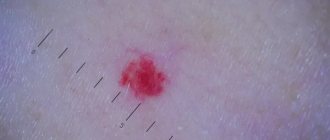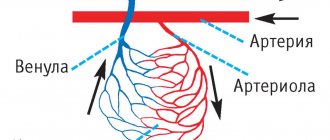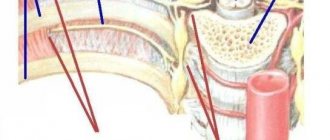Floaters before the eyes are floating spots of various shapes and sizes (dashes, lines, nets, cobwebs), which are clearly visible when looking at light-colored objects or a bright background. They are especially visible against the background of the sky, a white wall or snow.
Such floaters can appear in front of one or both eyes at the same time; occur periodically or be constant companions. Their distinctive feature is their floating nature. The flies seem to float following the movement of the eyes. When looking from object to object, they continuously repeat the same trajectory, only slightly delayed.
In most cases, the appearance of floaters before the eyes is not accompanied by unpleasant symptoms. But sometimes this phenomenon can be associated with a headache, flashes before the eyes or decreased vision.
Why do floaters appear before my eyes?
Most often, this symptom indicates destruction of the vitreous body.
This is a gel-like substance that fills the back surface of the eye. At birth, the vitreous body is tightly adjacent to the retina and has a homogeneous structure. But as the body ages, it is divided into two fractions (fibrous and liquid substance) and gradually peels off from the retina. When the vitreous body is detached, floating opacities and light flashes appear in the field of vision. Black spots before the eyes occur because the opaque fibers of the vitreous body cast a shadow on the retina. Flashes of light are a reaction of the retinal photoreceptors to the mechanical irritation that the exfoliating vitreous body exerts on it.
The appearance of floating spots and spots may be associated with other pathological conditions. For example, a foreign body entering the eye, retinal injuries, minor hemorrhages, visual fatigue. Sometimes floaters appear in the eyes due to inflammation of the eye tissue (uveitis), changes in blood pressure, cervical osteochondrosis, diabetes mellitus, and traumatic brain injury.
Diagnostics
During the initial examination by an ophthalmologist, it is necessary to establish under what circumstances symptoms appear (bright lighting, work at close range, at the height of a hypertensive crisis) and when they disappear. It is important to clarify the duration of the process. Basic diagnostic methods:
- Visometry.
Vitreous opacities of small size and peripheral localization do not affect visual acuity. With a pronounced degree of impairment, visual dysfunction can be observed. - Biomicroscopy of the eye.
With asteroid hyalosis, a large number of small yellowish or yellowish-white shiny formations are observed in the projection of the light beam. The effect of reflection is characteristic. However, the technique does not allow assessment of peripheral structures. - Ultrasound of the eye.
In gray scale B-mode, individuals with asteroid hyalosis show multiple small discrete echogenic inclusions with varying acoustic density. In A-mode, repeating high-amplitude complexes are recorded in the projection of the entire anechoic space of the vitreous cavity. - Spectral optical coherence tomography ( SD - OCT )
. OCT makes it possible to clearly visualize vitreal lesions located preretinal. With more anterior localization, they are indirectly detected as darkening of the OCT image. - Scanning laser ophthalmoscopy
. Depending on the density of the opacities, they look like white-gray shadows or penumbra. Using a series of photographs, you can estimate the size and approximate density. A Weiss ring is often detected in the fundus. - Dynamic Light Scattering ( DLS )
. The laser nanodetector system is used to image particles ranging in size from 3 nanometers to 3 microns. An ophthalmologist can evaluate collagen fiber aggregation in myopic or diabetic vitreopathy. - Determination of contrast sensitivity
. In the presence of primary compactions in the vitreous body, contrast sensitivity (CS) decreases. This increases the degree of light scattering. Studies are carried out before and after surgery. Asteroid hyalosis does not affect CP indicators.
Ophthalmological examination
Could eye floaters be a symptom of tear deficiency?
A change in the composition or amount of tear fluid is characteristic of a disease such as dry eye syndrome (DES). It can occur for various reasons:
- visual fatigue;
- taking certain medications (diuretics, antihistamines, antidepressants, etc.);
- age-related changes in the body;
- hormonal disbalance;
- long stay in a heated or air-conditioned room, outdoors in frosty and windy weather;
- general diseases (diabetes mellitus, rheumatoid arthritis, etc.).
Characteristic symptoms of dry eye syndrome include a burning sensation, “sand,” dry eyes, blurred vision (captivity), and floating spots. They appear because the eye tissues, when the functioning of the lacrimal apparatus changes, begin to experience a lack of moisture.
Relatively recently, a new remedy for dry eye syndrome - Delfanto® capsules - appeared on the Russian market. They are created on the basis of a standardized extract of Aristotelia chilean, which contains a record amount of antioxidants (at least 35%). The active substances of the capsules help get rid of the effects of oxidative stress and restore the functioning of the lacrimal apparatus.
Initially, a deficiency of tears leads to the appearance of minor signs of dry cornea, but as dry eye syndrome progresses, penetrating ulcers may appear on its surface. This can lead to serious consequences. Therefore, it is important to detect and “neutralize” the disease in time. But only a specialist can determine why floaters, veils, and a burning sensation appear in the eyes. Therefore, if unpleasant symptoms appear, you should consult an ophthalmologist.
Types of DST
| Type of DST | What's happening | How is it perceived by the patient? |
| Filamentous destruction | Compaction and subsequent gluing of collagen fibers | First - flies in the form of straight or curly threads, cobwebs, grayish-white stripes. Later - a characteristic pattern: the threads intersect with each other, forming loops. |
| Granular destruction | Formation of clusters of lymphocytes and pigment cells. Penetration of hyalocytes into the vitreous body. | Floating rings, dots. |
| DST with crystalline inclusions | Crystal formation (the process is not fully understood) | Bright silver or golden flashes, flickering |
In addition, during vitreous detachment, “special effects” in the form of lightning can be observed.
Out of sight or how to remove floaters?
First of all, you need to determine the reason for their appearance. A comprehensive examination will help you do this. If the appearance of floating spots or blurred vision is associated with overwork of the organ of vision, you need to give it a little rest. Gymnastics will be useful, as it helps improve microcirculation and eliminate muscle spasms.
Treatment of eye floaters associated with a lack of corneal hydration can be based on the use of eye drops. But it is important to understand that such solutions only temporarily eliminate the symptoms of dry eye syndrome, and have no effect on the very cause of the development of the disease.
Taking Delfanto® capsules helps provide natural hydration to the eyes by increasing tear production. This tool will be especially useful for people whose activities involve visual stress.
Only a doctor can tell you how to treat spots before your eyes in other cases. Sometimes laser treatment or cryotherapy (for retinal detachment), vitrectomy (for destruction of the vitreous body) is required. If the appearance of dots and spots drifting in the field of view is caused by diseases of the cervical spine, a course of physiotherapeutic procedures and the help of an orthopedist may be required.
Treatment
The flashing of flies before the eyes is not a sign of emergency conditions in ophthalmology. In 50% of cases, over time, floaters move below the visual axis, which allows patients to adapt to the symptoms. To alleviate the condition, it is recommended to limit exposure to bright lighting. If complaints persist for 3 months or more, then surgery should be considered.
Surgery
Today, only surgical methods for eliminating opacities are used in clinical practice. Pharmacological vitreolysis is at the stage of clinical trials. Intravitreal administration of a proteolytic enzyme helps to dissolve large opacities, but at the same time many small zones of destruction are formed. Main treatment methods:
- Vitrectomy.
The pathologically altered vitreous body, which is located along the optical axis, is removed. The retrolental part of the vitreous body remains unharmed, which makes it possible to avoid the development of postoperative cataracts. - YAG laser vitreolysis.
This intervention is performed by placing opacities directly behind the lens. The YAG laser makes it possible to destroy collagen fibers without having such a strong effect on hyaluronic acid.
1.General information
There are symptoms so universal, informative and, at the same time, difficult to describe verbally that the doctor and the patient sometimes have to make great efforts to correctly understand each other. In neuropsychiatric practice, such situations probably arise more often than in other medical fields. Indeed, widespread complaints that a patient has a “headache”, “feels bad” or “insomnia” may seem exhaustive and explain everything, although in fact such formulations acquire diagnostic significance only after numerous clarifications.
A huge number of nuances and options are implied, in particular, by the concept of “floaters before the eyes” (“floating circles”, “transparent spots”, “black dots”, etc.). Separated from other existing symptoms, these visual sensations in themselves do not even indicate which doctor should be consulted: an ophthalmologist, a neurologist, an endocrinologist, or perhaps several specialists at the same time. Only in the context of other, more specific health disorders, the situation gradually becomes clearer. It should be emphasized that such an ephemeral, obviously illusory and difficult to describe phenomenon, like foreign objects in the field of vision, most often serves as an alarm bell about latently growing problems, sometimes very serious ones.
A must read! Help with treatment and hospitalization!
Prevention measures
If floating black dots have just begun to appear in your field of vision. They still have a small number and do not reduce the quality of life, but they are already tiring with their presence, it is worth reconsidering the usual way of life. Perhaps by changing it, the problem will stop getting worse and there will simply be no reason to see a doctor. Here's what you need to change in your daily life:
- Become more active;
- Regularly engage in sports or physical activity;
- Be in the fresh air more often;
- Quit smoking;
- Do not abuse alcohol;
- Review your diet and ensure your body receives the required amount of vitamins and minerals;
- Get enough sleep;
- Limit visual stress.
In what cases should you consult a doctor?
An ophthalmologist should be visited in the following cases:
- Floaters appear when the brightness of the light increases.
- The number of such anomalies is constantly increasing .
- a history of progressive myopia.
- At the age of 50 years and older, floaters appear more often.
- The floaters began to appear after an injury to one or both eyes.
It is also necessary to visit a doctor if floaters appear in a “swarm” and do not disappear for a long time, and any part of the field of vision is darkened.
In conclusion
The appearance of black dots before the eyes can be a clear signal from the body that it needs to take care of its health. Therefore, if such a problem arises, you should rush to see a doctor. And if the specialist does not find anything dangerous in the situation, be sure to try to change your usual lifestyle, making it more active and correct. And most importantly, take care of your eyes: do not overstrain them, protect them from bright light, avoid shocks and injuries. Then sharp vision is guaranteed for many years!
By contacting the Moscow Eye Clinic, each patient can be sure that some of the best Russian specialists will be responsible for the results of treatment. The high reputation of the clinic and thousands of grateful patients will certainly add to your confidence in the right choice. The most modern equipment for the diagnosis and treatment of eye diseases and an individual approach to the problems of each patient are a guarantee of high treatment results at the Moscow Eye Clinic. We provide diagnostics and treatment for children over 4 years of age and adults.
You can find out the cost of a particular procedure or make an appointment at the Moscow Eye Clinic by calling 8(499)322-36-36









